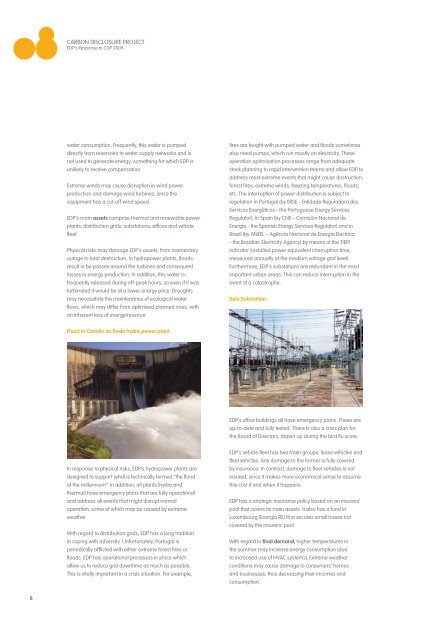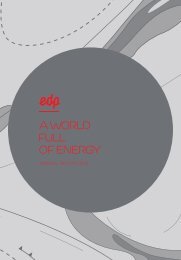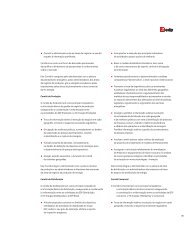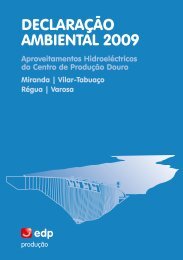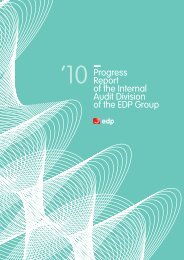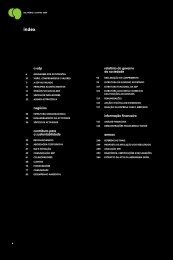CARBON DISCLOSURE PROJECT - EDP
CARBON DISCLOSURE PROJECT - EDP
CARBON DISCLOSURE PROJECT - EDP
Create successful ePaper yourself
Turn your PDF publications into a flip-book with our unique Google optimized e-Paper software.
6<br />
<strong>CARBON</strong> <strong>DISCLOSURE</strong> <strong>PROJECT</strong><br />
<strong>EDP</strong>’s Response to CDP 2009<br />
water consumption. Frequently, this water is pumped<br />
directly from reservoirs to water supply networks and is<br />
not used to generate energy, something for which <strong>EDP</strong> is<br />
unlikely to receive compensation.<br />
Extreme winds may cause disruption in wind power<br />
production and damage wind turbines, since the<br />
equipment has a cut-off wind speed.<br />
<strong>EDP</strong>’s main assets comprise thermal and renewable power<br />
plants, distribution grids, substations, offices and vehicle<br />
fleet.<br />
Physical risks may damage <strong>EDP</strong>’s assets, from momentary<br />
outage to total destruction. In hydropower plants, floods<br />
result in by-passes around the turbines and consequent<br />
losses in energy production. In addition, this water is<br />
frequently released during off-peak hours, so even if it was<br />
turbinated it would be at a lower energy price. Draughts<br />
may necessitate the maintenance of ecological water<br />
flows, which may differ from optimised planned ones, with<br />
an inherent loss of energy/revenue.<br />
Flood in Castelo do Bode hydro power plant<br />
In response to physical risks, <strong>EDP</strong>’s hydropower plants are<br />
designed to support what is technically termed “the flood<br />
of the millennium”. In addition, all plants (hydro and<br />
thermal) have emergency plans that are fully operational<br />
and address all events that might disrupt normal<br />
operation, some of which may be caused by extreme<br />
weather.<br />
With regard to distribution grids, <strong>EDP</strong> has a long tradition<br />
in coping with adversity. Unfortunately, Portugal is<br />
periodically afflicted with either extreme forest fires or<br />
floods. <strong>EDP</strong> has operational processes in place which<br />
allow us to reduce grid downtime as much as possible.<br />
This is vitally important in a crisis situation. For example,<br />
fires are fought with pumped water and floods sometimes<br />
also need pumps, which run mostly on electricity. These<br />
operation optimisation processes range from adequate<br />
stock planning to rapid intervention teams and allow <strong>EDP</strong> to<br />
address most extreme events that might cause destruction:<br />
forest fires, extreme winds, freezing temperatures, floods,<br />
etc. The interruption of power distribution is subject to<br />
regulation in Portugal (by ERSE - Entidade Reguladora dos<br />
Serviços Energéticos - the Portuguese Energy Services<br />
Regulator), in Spain (by CNE – Comisión Nacional de<br />
Energía - the Spanish Energy Services Regulator) and in<br />
Brazil (by ANEEL – Agência Nacional de Energia Electrica<br />
- the Brazilian Electricity Agency) by means of the TIEPI<br />
indicator (installed power equivalent interruption time,<br />
measured annually at the medium voltage grid level).<br />
Furthermore, <strong>EDP</strong>’s substations are redundant in the most<br />
important urban areas. This can reduce interruption in the<br />
event of a catastrophe.<br />
Seia Substation<br />
<strong>EDP</strong>’s office buildings all have emergency plans. These are<br />
up-to-date and fully tested. There is also a crisis plan for<br />
the Board of Directors, drawn up during the bird flu scare.<br />
<strong>EDP</strong>’s vehicle fleet has two main groups: lease vehicles and<br />
fleet vehicles. Any damage to the former is fully covered<br />
by insurance. In contrast, damage to fleet vehicles is not<br />
insured, since it makes more economical sense to assume<br />
this cost if and when it happens.<br />
<strong>EDP</strong> has a strategic insurance policy based on an insurers’<br />
pool that covers its main assets. It also has a fund in<br />
Luxembourg (Energia RE) that secures small losses not<br />
covered by the insurers’ pool.<br />
With regard to final demand, higher temperatures in<br />
the summer may increase energy consumption (due<br />
to increased use of HVAC systems). Extreme weather<br />
conditions may cause damage to consumers’ homes<br />
and businesses, thus decreasing their incomes and<br />
consumption.


